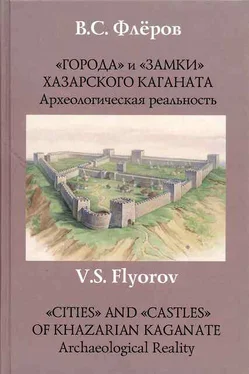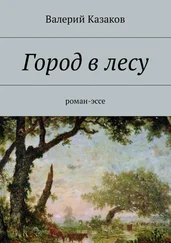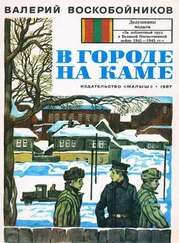The problem of a «Khazar town» was introduced into the khazar studies by S. A. Pletneva in the book «От кочевий к городам / From the nomads’ camps to towns» (Плетнёва C. A., 1967). The title reflects the straight forwardness of the scheme of the kaganate development. Pletneva has considered as towns Itil, Sarkel, Semikarakory, Semender and «others that have not been studied» (Плетнёва C. A., 1967, c.44–48). Later the list was changed, and Semikarakory was ex-eluded (Плетнёва C. A., 1987, 2002). Her terminology is not stable: town, a provincial border small town, a steppe town, etc.
V. S. Flyorov mainly considers the sites of ancient settlements — a stone and brick fortification of Don — Seversky Donets basin, where the culture of the Khazar kaganate, that is Saltovo-Mayatsky culture, had formed and developed in its pure shape. Exactly for this region the question of Khazaria «towns» must be solved. The monuments of the Crimea, Dagestan, and Chechnia are also used, for which one may come across the definition «a town of Khazaria»
In the quest of khazar towns two features are taken into account:
1. The architectural and planning aspect It archaeologically (up to visualization) distinguishes a town from a village/hamlet. The social structure of the urban population, its composition and organiza-tion is reflected in it. After all the character of the settlement as that of a town (not a village!) was determined neither by the houses of the nobility/aristocracy, nor by cult buildings, but by the type of the houses of the ordinary populace with its way of life and occupations.
2. The structure . The feature is not simple. It is not clear what must be included into the composition of a «town», only the sites or the adjoining open settlements together with them. Some authors are beginning to toy with the term «nocaA»/suburb.
THE DON — SEVERSKY DONETS BASIN
The sites that have been studied, which earlier were called «towns» or «castles» are not such: Sarkel — Belaya Vezha, Semikarakory, Pravobe-rezhnoye Tsymlyanskoye, Mayatskoye, Verghni Olshan, Verchneye Saltovo, Mayaki. There are ordinary houses, semi-dugouts or yurt-type ones at all of them, there is no street planning, and agriculture prevails. There are no archaeological features of a town. Here are some examples.
Sarkel (111.1, 2). As a rule M. I. Artamonov called Sarkel a fortress and not a town (Артамонов М. И., 1958). S. A. Pletneva called Sarkel a town or a small town, and then caravanserai. Sarkel (the Levobe-rezhnoye Tsymlyanskoye site) is a tiny brick fort, 178.6 x 117.8 m along the inner perimeter. The houses have no characteristics dis-tinguishing them from those known from rural settlements. The material culture, too, has nothing special about it. The brick rooms inside the fort are hardly suitable to live in, especially in winter. Most probably they are store-houses for provisions in case of a siege and arsenals.
The excavations have given no reason to suppose that the main function of Sarkel was «commercial and customs activity» which S. A. Pletneva ascribed to it.
Semikarakory (111.3,4) is a fortress made of adobe with structures of baked brick. Probably, it was the residence of the kagans (Флёров B. C., 2001, 2009a, 20096). The considerable part of the fortress is not built.
Verhnee Saltovo (111.17). D. T. Berezovets (Археология УРСР, 1975, c.422) was one of the first to have written about it as a «town» later A. V. Kryganov (2001a, c. 102) tried to prove it. His description is an unreliable supposition with the predominance of emotion. He called the monument an «administrative and commercial centre» in the north-west of kaganate (Крыганов A. B., 1997, c.57). V. S. Flyorov considers the site to have been an ordinary fortress with adjoining settlements. It is badly explored. The size of the settlements and the burial ground are not known.
About the term «prototown» The question about it was put forward by V. V. Koloda (2009); he admitted that the existence of towns in the Khazar kaganate was open to question. According to Koloda, Verkhni Saltov, Chuguevskoye, Mokhnach, Korobovy Khutora, Sukhaya Gomolsha, Sidorovskoye, Mayaki, Yutanovskoye, Mayatskoye were prototowns. V. S. Flyorov thinks it to be a «game of terms». There is no sense to raise the question about the «prototowns» in the Khazar kaganate, because not a single one of the listed places had become a town.
«CASTLES» OR SOMETHING ELSE
In her book «From nomads’ camps to towns» S. A. Pletneva expressed an opinion that six settlements with earthen ramparts — «these big fenced settlements can be considered to be one of the primary forms of the „feudal nomadic castles “» (Плетнева C. A., 1967, c.24) as well as 12 fortresses of white stones, including the Pravoberezhnaya Tsym-lyanskaya one. However, these monuments have nothing to indicate the presence of the feudal class. Some have not been excavated at all. The burial grounds of the kaganate are the evidence of very inconsiderable property stratification. The notion «castle» (das Schloß in German) has entered our country’s historiography from West European studies of the Middle Ages, but it should be taken into account that social processes have gone along a different way in Europe.
ITIL
It remains unclear where Itil was. The author has tried to reconstruct how it looked on the basis of the sources of the «Caspian code» by B. N. Zakhoder. It has turned out that it is impossible to calculate its sizes, the number of the population, including the Christians, Moslems and Jews. There is no initial data to reconstruct the «palace» If an attempt is to be made to recreate a model of Itil in a verbal or graphic way it will hardly be possible to get anything integral on the basis of contradictory and fragmentary information. The conclusion made half a century ago still remains valid: «Many essential questions of the topography and history of Itil cannot be solved even in the form of a hypothesis, and it is not known whether the materials necessary for solving them will ever be found» (Заходер Б. Н., 1963, c.198). Zakhoder s remark is correct: Itil is a large populated place with the beginnings (not more!) of urban life and the predominance of agriculture. The remains of Itil are claimed by the site of Samos-delka in the Volga Delta.
Samosdelka. The author has used nearly all publications about the site (Васильев Д. В., Гречкина Т. Ю., Зиливинская Э. Д., 2003, с. 106; Зиливинская Э. Д., 2007, 2010; Зиливинская Э.Д, Васильев Д. В., 2008,2009) and has come to the following conclusion: it has not been studied sufficiently to draw any conclusions. There are no statistics about the size of bricks to compare them with the bricks of Sarkel. The date of founding is not established. The methods of excavations are not satisfactory, and the ceramics is not treated.
KHUMARA
It is the biggest fortress of the Khazar kaganate (111.20–22). Khumara could be considered a town, but the nearly complete lack of the study of the inner space is an obstacle to it. There is no data about the remains of solid structures, and the few ones that are excavated are ordinary semi-dugouts.
DAGESTAN
Belendjer and Semender have not yet been found. Probably, they were «large populated places» with simple dwellings and a rural pop-ulation.
Verkhni Chir-Yurt (111.24). The site is not explored. The purpose of the stone wall was dam the valley of the Sulak River.
Andrey-aul (111.25). An open settlement founded in the beginning of the common era adjoins the site. Compared with the total area of the monument the explored parts are microscopic (Атаев Д. М., Магомедов М. Г., 1974). There is no information about either the structure of the site on the whole, or about the purpose of its separate parts. The planning and the density of construction are not known.
Читать дальше
Конец ознакомительного отрывка
Купить книгу











